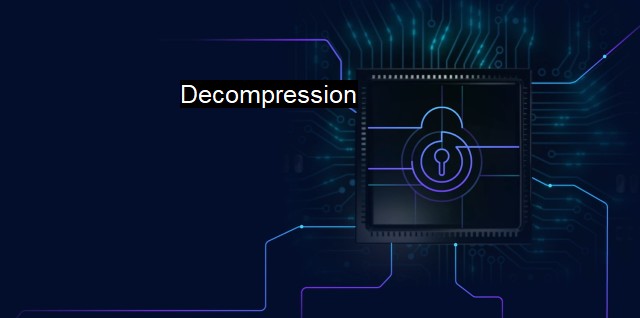What is Decompression?
The Significance and Importance of Decompression in Cybersecurity and Information Technology
Decompression, in the context of cybersecurity and antivirus protection, refers to the method of returning compressed data or files to their original form. As an essential technical process employed in computer systems and networks, it serves the primary purpose of enhancing storage utilization while optimizing data transmission effectively across networks.Cybersecurity initiatives frequently involve the utilization of compression and decompression technology. Compressing data aids in lessening the size of files being transmitted or stored, which in turn reduces storage usage and enriches the speed of data transmission. Correspondingly, decompression is required to revert the compressed data to its original size to make it meaningful and accessible for analysis or further use.
In particular, cybersecurity companies utilize file compression/decompression when transmitting software updates or patches. These updates are initially ""compressed"" to minimize their size, transmitted, and then decompressed at the receiver's end for implementation. Reduced data sizes also accelerate download speeds and lessen the load on the server or network, bolstering the effectiveness of download processes, even during peak usage or high traffic times.
It's crucial to note that decompression isn't a risk-free action in the cybersecurity context. Cases abound where cybercriminals exploit data compression to inject harmful code into compressed files. Because antivirus tools may find it challenging to analyze the contents of a compressed file, it may allow harmful files to remain undetected and infiltrate systems, thereby raising potential security risks.
Decompression bombs are a type of bait frequently used by cybercriminals. They employ specific compression algorithms to balloon small files unnoticeably into massive ones upon decompression. The colossal size can retaliate either crashing the system or causing it to slow down sufficiently for the attacker to maneuver malevolent activities gratuitously.
Every compressed file, therefore, signifies a potential security threat. As such, advanced antivirus software today comes equipped with algorithms that not only decompress data files but also analyze file behavior upon decompression. Given their significance, these decompression features come built into the scanning engines of the antivirus software, extending the scope and range of detection.
Insofar as security vectors are concerned, malicious software embedded within compressed files can be opened automatically by the host system upon decompression. Cybersecurity tools will, therefore, scrutinize such executables and quarantine threats appropriately.
When transferring files, the compression of files can hide potential threats from detection by software meant to shield against malware. As a counteraction, the process of decompression brings these files back to their original status for thorough and efficient scanning and detection of malicious data.
Notably, such ceaseless endeavors in expanding antivirus software abilities to span compressed files signify the progression and evolution in the realm of cybersecurity. Given the crucial cybersecurity facet that decompression represents, businesses and individuals must employ antivirus software with cutting edge decompression capabilities.
Organizations must ensure that their cybersecurity strategy is robust enough to swat any potential time bombs. Cybersecurity professionals must likewise remain proficient about the ongoing advancements in this space.
Decompression, as profiled within the realms of cybersecurity and antivirus software, commands substantial influence over the accuracy and effectiveness of cybersecurity initiatives. By meeting the dual purposes of enhancing data transmission and enabling the efficient examination of malware threats buried within compressed files, decompression aligns cybersecurity capabilities with present-day challenges and beyond.

Decompression FAQs
What is decompression in the context of cybersecurity and antivirus?
In cybersecurity and antivirus, decompression refers to the process of unpacking compressed files or archives that may contain malicious software or viruses. The decompression process allows the security software to scan the contents of the compressed files for any potential threats.How does decompression help in detecting malware or viruses?
Decompression helps in detecting malware or viruses as compressed files often contain multiple files and code that may be encrypted or hidden within the archive. By decompressing the file, the antivirus software can access the contents of the compressed archive and scan each file for any malicious code or behavior.What are some common compressed file formats that may contain malware or viruses?
Some common compressed file formats that may contain malware or viruses are ZIP, RAR, and 7z. These formats are often used to compress and share files online, making them a popular choice for cybercriminals to hide their malicious code.Is decompression always safe to perform?
While decompression is generally safe, there is still a risk of exposing your system to malware or viruses if the compressed file contains malicious code. It is important to always have antivirus software installed and updated on your system and to only decompress files from trusted sources.Related Topics
Malware analysis Vulnerability scanning Intrusion detection Penetration testing Endpoint security
| | A | | | B | | | C | | | D | | | E | | | F | | | G | | | H | | | I | | | J | | | K | | | L | | | M | |
| | N | | | O | | | P | | | Q | | | R | | | S | | | T | | | U | | | V | | | W | | | X | | | Y | | | Z | |
| | 1 | | | 2 | | | 3 | | | 4 | | | 7 | | | 8 | | |||||||